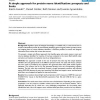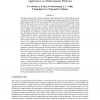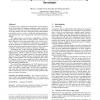1058 search results - page 205 / 212 » MEMOPS: Data modelling and automatic code generation. |
ICDE
2003
IEEE
14 years 8 months ago
2003
IEEE
Analyzing sequence data has become increasingly important recently in the area of biological sequences, text documents, web access logs, etc. In this paper, we investigate the pro...
CIKM
2009
Springer
14 years 1 months ago
2009
Springer
Understanding intents from search queries can improve a user’s search experience and boost a site’s advertising profits. Query tagging via statistical sequential labeling mode...
BMCBI
2005
13 years 7 months ago
2005
Background: Significant parts of biological knowledge are available only as unstructured text in articles of biomedical journals. By automatically identifying gene and gene produc...
TOMS
1998
13 years 7 months ago
1998
This paper presents the software architecture and implementation of the problem solving environment (PSE) PELLPACK for modeling physical objects described by partial differential ...
ASPLOS
2006
ACM
14 years 1 months ago
2006
ACM
Concurrency bugs are among the most difficult to test and diagnose of all software bugs. The multicore technology trend worsens this problem. Most previous concurrency bug detect...



